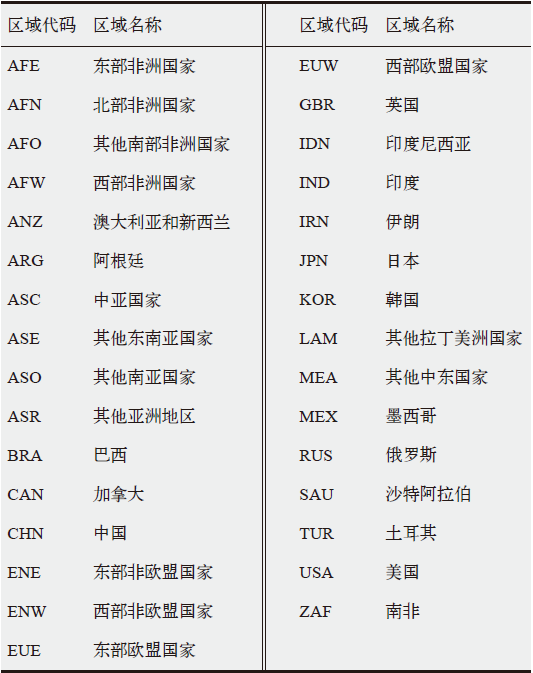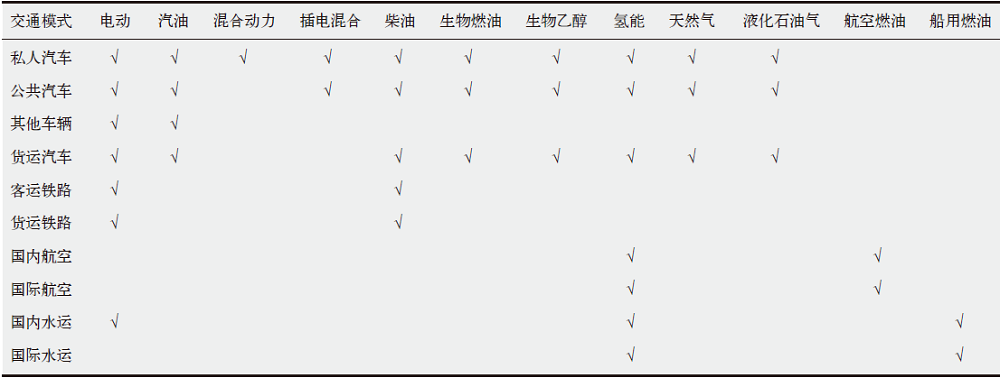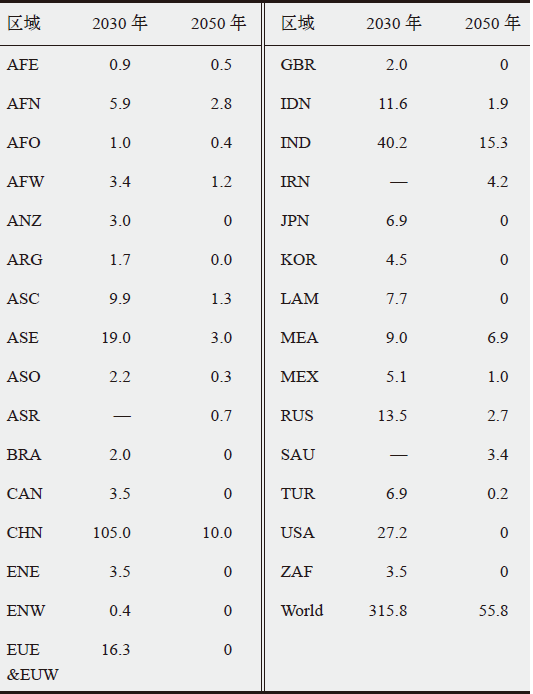气候变化研究进展 ›› 2023, Vol. 19 ›› Issue (2): 203-212.doi: 10.12006/j.issn.1673-1719.2022.184
碳中和目标下全球交通能源转型路径
- 1 清华大学现代管理研究中心,北京 100084
2 清华大学能源环境经济研究所,北京 100084
-
收稿日期:2022-08-04修回日期:2022-11-14出版日期:2023-03-30发布日期:2023-02-03 -
作者简介:李丹阳,男,博士,lidy12@tsinghua.org.cn -
基金资助:国家自然科学基金(71690243);国家自然科学基金(51861135102);教育部人文社会科学重点研究重大项目(22JJD48001)
Global transportation energy transition pathways towards carbon neutrality
LI Dan-Yang1,2( ), CHEN Wen-Ying1,2
), CHEN Wen-Ying1,2
- 1 Research Center for Contemporary Management, Tsinghua University, Beijing 100084, China
2 Institute of Energy, Environment and Economy, Tsinghua University, Beijing 100084, China
-
Received:2022-08-04Revised:2022-11-14Online:2023-03-30Published:2023-02-03
摘要:
《巴黎协定》提出将21世纪末全球温升控制在2℃以内并努力控制在1.5℃以内。截至2021年11月,超过140个国家已经或考虑提出碳中和目标,覆盖全球90%的排放,充分体现了新气候治理体系下各国深度减排的雄心。交通部门作为重要的终端能源消费部门,在各地区实现碳中和目标的路径中发挥重要作用。本文使用自主构建的全球31区能源系统模型GTIMES 2.0对碳中和目标下交通能源转型路径进行模拟。结果表明:碳中和目标下全球交通能源系统将发生深刻变革,交通碳排放将于2030年达到峰值85亿t,2050年降至27亿t,同时交通用能中超过60%将转换为电力和氢能。道路运输未来仍是交通部门最大的碳排放源,航空运输由于需求增长较快、减排难度较大,未来碳排放占比会明显上升。各国交通减排路径存在差异,全球31个区域中包括欧盟、英国、日本、韩国等11个区域交通碳排放在2018年已经达峰,中国、“一带一路”沿线区域、印度等将于2030年或之后达峰。2050年,23个区域交通碳排放相对2018年下降50%以上,但印度相对2018年仍然明显上升。
引用本文
李丹阳, 陈文颖. 碳中和目标下全球交通能源转型路径[J]. 气候变化研究进展, 2023, 19(2): 203-212.
LI Dan-Yang, CHEN Wen-Ying. Global transportation energy transition pathways towards carbon neutrality[J]. Climate Change Research, 2023, 19(2): 203-212.

图2 碳中和目标下2050年各区域交通能源消费中电力和氢能占比
Fig. 2 Electricity and hydrogen proportion of transportation energy consumption towards carbon neutrally targets in each region

图3 碳中和目标下各区域峰值和2050年交通碳排放相对2018年变化比例
Fig. 3 Relative changes of peak and 2050 transportation carbon emissions in 2018 for each region towards carbon neutrally targets
| [1] | United Nations Framework Convention on Climate Change (UNFCCC). Adoption of the Paris Agreement[R]. Paris, 2015 |
| [2] |
Kyle P, Kim S H. Long-term implications of alternative light-duty vehicle technologies for global greenhouse gas emissions and primary energy demands[J]. Energy Policy, 2011, 39 (5): 3012-3024
doi: 10.1016/j.enpol.2011.03.016 URL |
| [3] |
Pietzcker R C, Longden T, Chen W, et al. Long-term transport energy demand and climate policy: alternative visions on transport decarbonization in energy-economy models[J]. Energy, 2014, 64: 95-108
doi: 10.1016/j.energy.2013.08.059 URL |
| [4] |
Yin X, Chen W, Eom J, et al. China’s transportation energy consumption and CO2 emissions from a global perspective[J]. Energy Policy, 2015, 82: 233-248
doi: 10.1016/j.enpol.2015.03.021 URL |
| [5] |
Hache E, Seck G S, Simoen M, et al. Critical raw materials and transportation sector electrification: a detailed bottom-up analysis in world transport[J]. Applied Energy, 2019, 240: 6-25
doi: 10.1016/j.apenergy.2019.02.057 URL |
| [6] |
Zhang R, Fujimori S, Dai H, et al. Contribution of the transport sector to climate change mitigation: insights from a global passenger transport model coupled with a Computable General Equilibrium model[J]. Applied Energy, 2018, 211: 76-88
doi: 10.1016/j.apenergy.2017.10.103 URL |
| [7] |
Mittal S, Dai H, Fujimori S, et al. Key factors influencing the global passenger transport dynamics using the AIM/transport model[J]. Transportation Research Part D: Transport and Environment, 2017, 55: 373-388
doi: 10.1016/j.trd.2016.10.006 URL |
| [8] |
Ruhnau O, Bannik S, Otten S, et al. Direct or indirect electrification? A review of heat generation and road transport decarbonisation scenarios for Germany 2050[J]. Energy, 2019, 166: 989-999
doi: 10.1016/j.energy.2018.10.114 URL |
| [9] |
Andress D, Nguyen T D, Das S. Reducing GHG emissions in the United States’ transportation sector[J]. Energy for Sustainable Development, 2011, 15 (2): 117-136
doi: 10.1016/j.esd.2011.03.002 URL |
| [10] |
Haasz T, Gómez Vilchez J J, Kunze R, et al. Perspectives on decarbonizing the transport sector in the EU-28[J]. Energy Strategy Reviews, 2018, 20: 124-132
doi: 10.1016/j.esr.2017.12.007 URL |
| [11] |
Li Y, Chang Y. Road transport electrification and energy security in the association of Southeast Asian nations: quantitative analysis and policy implications[J]. Energy Policy, 2019, 129: 805-815
doi: 10.1016/j.enpol.2019.02.048 URL |
| [12] |
Talebian H, Herrera O E, Tran M, et al. Electrification of road freight transport: policy implications in British Columbia[J]. Energy Policy, 2018, 115: 109-118
doi: 10.1016/j.enpol.2018.01.004 URL |
| [13] |
Pan X, Wang H, Wang L, et al. Decarbonization of China’s transportation sector: in light of national mitigation toward the Paris Agreement goals[J]. Energy, 2018, 155: 853-864
doi: 10.1016/j.energy.2018.04.144 URL |
| [14] |
Khanna N, Fridley D, Zhou N, et al. Energy and CO2 implications of decarbonization strategies for China beyond efficiency: modeling 2050 maximum renewable resources and accelerated electrification impacts[J]. Applied Energy, 2019, 242: 12-26
doi: 10.1016/j.apenergy.2019.03.116 |
| [15] |
Peng T, Ou X, Yuan Z, et al. Development and application of China provincial road transport energy demand and GHG emissions analysis model[J]. Applied Energy, 2018, 222: 313-328
doi: 10.1016/j.apenergy.2018.03.139 URL |
| [16] |
Zhao F, Liu F, Liu Z, et al. The correlated impacts of fuel consumption improvements and vehicle electrification on vehicle greenhouse gas emissions in China[J]. Journal of Cleaner Production, 2019, 207: 702-716
doi: 10.1016/j.jclepro.2018.10.046 URL |
| [17] |
Wang H, Ou X, Zhang X. Mode, technology, energy consumption, and resulting CO2 emissions in China’s transport sector up to 2050[J]. Energy Policy, 2017, 109: 719-733
doi: 10.1016/j.enpol.2017.07.010 URL |
| [18] |
Zhao L, Chang S, Wang H, et al. Long-term projections of liquid biofuels in China: uncertainties and potential benefits[J]. Energy, 2015, 83: 37-54
doi: 10.1016/j.energy.2015.01.060 URL |
| [19] |
Li P, Zhao P, Brand C. Future energy use and CO2 emissions of urban passenger transport in China: a travel behavior and urban form based approach[J]. Applied Energy, 2018, 211: 820-842
doi: 10.1016/j.apenergy.2017.11.022 URL |
| [20] |
Hao H, Geng Y, Li W, et al. Energy consumption and GHG emissions from China’s freight transport sector: scenarios through 2050[J]. Energy Policy, 2015, 85: 94-101
doi: 10.1016/j.enpol.2015.05.016 URL |
| [21] | Loulou R, Remne U, Kanudia A, et al. Documentation for the TIMES model: part 1[EB/OL]. 2005 [2021-03-01]. https://iea-etsap.org/index.php/documentation |
| [22] | International Energy Agency (IEA). World energy balances[EB/OL]. 2021 [2021-08-01]. http://data.iea.org |
| [23] | International Institute for Applied Systems Analysis. SSP public database-version 2.0[EB/OL]. 2018 [2021-08-01]. https://tntcat.iiasa.ac.at/SspDb/dsd?Action=htmlpage&page=welcome |
| [24] | International Organization of Motor Vehicle Manufacturers. World vehicles in use[EB/OL]. 2016 [2021-08-01]. https://www.oica.net/category/vehicles-in-use/ |
| [25] |
Huo H, Wang M. Modeling future vehicle sales and stock in China[J]. Energy Policy, 2012, 43: 17-29
doi: 10.1016/j.enpol.2011.09.063 URL |
| [26] | International Civil Aviation Organization (ICAO). Annual report 2018: air transport statistics[EB/OL]. 2018 [2021-08-01]. https://www.icao.int/annual-report-2018/Pages/the-world-of-air-transport-in-2018-statistical-results.aspx |
| [27] | International Union of Railways. Railisa: UIC statistics[EB/OL]. 2021 [2021-08-01]. https://uic-stats.uic.org/ |
| [28] | Joint Global Change Research Institute. Global Change Analysis Model (GCAM)[EB/OL]. 2019 [2019-09-05]. http://www.globalchange.umd.edu/gcam/ |
| [29] | Mishra G S, Kyle P, Teter J, et al. Transportation module of Global Change Assessment Model (GCAM) model documentation[EB/OL]. 2021 [2021-09-01]. https://escholarship.org/uc/item/8nk2c96d |
| [1] | 杨姗姗, 郭豪, 杨秀, 李政. 双碳目标下建立碳排放总量控制制度的思考与展望[J]. 气候变化研究进展, 2023, 19(2): 191-202. |
| [2] | 樊星, 李路, 秦圆圆, 高翔. 主要发达经济体从碳达峰到碳中和的路径及启示[J]. 气候变化研究进展, 2023, 19(1): 102-115. |
| [3] | 李品, 谢晓敏, 黄震. 德国能源转型进程及对中国的启示[J]. 气候变化研究进展, 2023, 19(1): 116-126. |
| [4] | 林泽伟, 汪鹏, 任松彦, 许鸿伟, 张聪, 赵黛青. 能源转型路径的经济环境健康效益评估——以粤港澳大湾区为例[J]. 气候变化研究进展, 2022, 18(6): 777-790. |
| [5] | 郭偲悦, 耿涌. IPCC AR6报告解读:工业部门减排[J]. 气候变化研究进展, 2022, 18(5): 574-579. |
| [6] | 白泉, 胡姗, 谷立静. 对IPCC AR6报告建筑章节的介绍和解读[J]. 气候变化研究进展, 2022, 18(5): 557-566. |
| [7] | 闫书琪, 李素梅, 吕鹤, 陈莎, 刘影影, 王宏涛, 刘会政, 陈前利. 基于混合LCA的新疆地区电力生产水足迹分析及碳中和目标下的变化[J]. 气候变化研究进展, 2022, 18(3): 294-304. |
| [8] | 曾桉, 谭显春, 王毅, 高瑾昕. 国际气候投融资监测、报告与核证制度及启示[J]. 气候变化研究进展, 2022, 18(2): 215-229. |
| [9] | 张浩楠, 申融容, 张兴平, 康俊杰, 袁家海. 中国碳中和目标内涵与实现路径综述[J]. 气候变化研究进展, 2022, 18(2): 240-252. |
| [10] | 任佳雪, 高庆先, 陈海涛, 孟丹, 张阳, 马占云, 刘倩, 唐甲洁. 碳中和愿景下的污水处理厂温室气体排放情景模拟研究[J]. 气候变化研究进展, 2021, 17(4): 410-419. |
| [11] | 王利宁, 陈文颖, 戴家权, 向征艰, 龚金双. 智能互联重塑中国能源体系[J]. 气候变化研究进展, 2021, 17(2): 204-211. |
| [12] | 姜克隽, 冯升波. 走向《巴黎协定》温升目标:已经在路上[J]. 气候变化研究进展, 2021, 17(1): 1-6. |
| [13] | 张雅欣, 罗荟霖, 王灿. 碳中和行动的国际趋势分析[J]. 气候变化研究进展, 2021, 17(1): 88-97. |
| 阅读次数 | ||||||
|
全文 |
|
|||||
|
摘要 |
|
|||||






